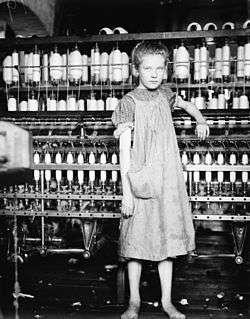Keating–Owen Act
.svg.png) | |
| Other short titles | An act to prevent interstate commerce in the products of child labor, and for other purposes |
|---|---|
| Enacted by | the 64th United States Congress |
| Effective | September 1, 1916 |
| Legislative history | |
| |
| United States Supreme Court cases | |
| Hammer v. Dagenhart 247 U.S. 251 (1918) | |
The Keating-Owen Child Labor Act of 1916 also known as Wick's Bill, was a short-lived statute enacted by the U.S. Congress which sought to address child labor by prohibiting the sale in interstate commerce of goods produced by factories that employed children under fourteen, mines that employed children younger than sixteen, and any facility where children under fourteen worked after 7:00 p.m. or before 6:00 a.m. or more than 8 hours daily. The Bill was accepted after its first failure to be enacted, was revised and re-introduced. The basis for the action was the constitutional clause giving Congress the task of regulating intrastate commerce. The Act specified that the U.S. Attorney General, the Secretary of State and the Secretary of Agriculture would convene a caucus to publish from time to time uniform rules and regulations to comply with the Act. To enforce the Act, the Secretary of Labor would assign inspectors to perform inspections of workplaces that produce goods for commerce. The inspectors would have the authority to make unannounced visits and would be given full access to the facility in question. Anyone found in acceptance of this Act or who gave false evidence would be subject to fines and/or imprisonment.
History

The bill was named for its sponsors, Edward Keating and Robert Latham Owen. The work of Alexander McKelway and the National Child Labor Committee (NCLC),[2] it was signed into law by President Woodrow Wilson, who had lobbied heavily for its passage, in 1916 and went into effect September 1, 1917, but nine months later, in Hammer v. Dagenhart, 247 U.S. 251 (1918),[3] the Act was ruled unconstitutional by the Supreme Court of the United States (see also Lochner era).
References
- ↑ US Stamp gallery
- ↑ Child Labor: A World History Companion By Sandy Knobbs, Jim McKechnie, Michael Lavalette
- ↑ "Abbott, Grace". Encyclopedia Britannica. I: A-Ak - Bayes (15th ed.). Chicago, IL: Encyclopedia Britannica, Inc. 2010. p. 13. ISBN 978-1-59339-837-8.
External links
- Keating Owen Child Labor Act, 1916
- American Government Roots and reform AP Edition by O'Connor Sabato Yanus